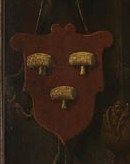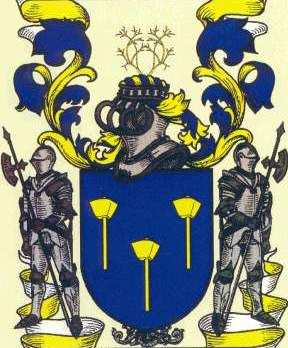Biography of William Browne Esq


Wool merchant mark of William Browne Arms of Margaret Browne (nee Stock)
Born c1410
Death 14 April 1489
General Wool Merchant, Mayor, Justice of the Peace, Sherriff, Benefactor. Acquired during his lifetime around 200 properties and 10,000 acres of land including the Manor of Lilford.
Father John Browne (Wool merchant) d1442
Mother Margery (aka Marjery/Margaret) d1460
Spouse
Name Dame Margaret Stock (aka Stokke/Stokes)
Death 28 October 1489
General Heiress of Manor of Warmington
Father John Stock
Mother Agnes Stock ( -1465)
Marriage c1430s
Children Elizabeth (c1441-1511)
Notes for William Browne Esq:
c1410 Born into the Browne family who were at that time the most prominent family in the town of Stamford in the County of Lincolnshire, and whose lavish brasses still decorate the floor of All Saints' Church. The Brownes were wool merchants and Staplers, since they were members of the English-owned wool Company of the Staple at Calais (now in present day France), the Calais staple being a vital link for trade with the Continent. From 1314, the Crown required all wool for export to be traded at a designated market, called 'the staple". This allowed the Crown to monitor the trade and levy tax on exports. The Merchants of the Staple, also known as the Merchant Staplers, was an English company which controlled the export of wool to the continent during the late medieval period. After Calais was conquered in 1347 by the English, Calais was the staple from 1363. A group of twenty-six traders was incorporated as the Company of the Staple at Calais. In exchange for its cooperation in the payment of taxes, the company was granted a total monopoly on wool exports from England. The company was important to the English crown, both as a source of revenue, and through its role in the defence of Calais against the French. In particular, the Staple bankrolled successive kings in return for grants of land in the king's hands due to forfeiture from those who fought against the king.
c1430s Marries Margaret Stock (aka Stokke/Stokes) whose family owns the Manor of Warmington in Northamptonshire.
1435 First elected Alderman (i.e. Mayor) of Stamford (one of the wealthest towns in the country at that time). He was very active in the civic life of Stamford, being a town councillor for around 55 years, and serving six times as Alderman between 1435 and 1470.
1436 Father (John Browne) hands over drapery and general stock side of business to William who was then a draper, this part of the business being based out of a large shop (formerly four shops) in the main market place of Stamford and warehouses at the rear.
1439 Obtains a comprehensive exemption from crown service so as to concentrate on his growing business interests.
c1440 Justice of the Peace (a type of Judge) in both Rutland and Kesteven (Lincolnshire) Courts
c1440 William Browne becomes the most outstanding member of the Brownes family. John Leland, writing in the mid-sixteenth century, described him in his book ‘The Itinerary of John Leland the Antiquary’ as “a merchant of very wonderfulle richnesse”. He came to dominate Stamford, paying the same tax as all the bakers, brewers and innkeepers put together.
1444 and 1449 Alderman of Stamford.
1446 Appointed as ambassador for the merchants of Holland, Zeeland and Flanders to the Duke of Burgundy.
1449 member ot the Calais staple at least from this year. As member he engages in moneylending, in particular to successive Kings of England, namely Henry VI, Edward IV, Edward V, Richard III and Henry VII in return for forfeited properties, licenses to export wool free of tax, and at least five royal pardons. Most of his moneylending activities took place during the War of the Roses which took place between 1455 and 1485.
1450 elector of the Members of Parliament from Lincolnshire.
1450s to 1470’s William Browne becomes an extremely large land and property owner, with around 1500 title deeds covering an estimated 10,000 acres and 200 houses mainly in and around Stamford, including the whole of the Manors of Swafield (Swayfield) and North Witham, as well as Wothorpe, St.Martin’s, North Luffenham, Sculthorpe (Scottlethorpe), Stretton, Stretton-Stokin (Stretton-Stoken), Thiftleton (Thistleton), Eafendine (Essendine), South Witham, Twiford (Twyford), Woolfthorpe (Woolsthorpe), Barholm, Colfterworth (Colsterworth), Steynby (Stainby), Caftle Bytham (Castle Bytham), Cownthorpe (Counthorpe), Careby, Eafton (Easton), Berrack (Barnack), Walcott, Pilfgate (Pilsgate) and Cafton (Casterton). He also owned several farms, messuages, lands and tenements in Stamford itself. At today’s value, his assets are estimated to be worth around £100 million, and thus Leland was not exaggerating when he described him as “of very wonderfulle richnesse”!
1456 He acquires the Manor of Papley in Northamptonshire, next to the Manor of Warmington belonging to his wife’s family, and close to Lilford.
c1457 The daughter and sole heiress of William Browne, Elizabeth Browne, marries Sir Thomas Elmes of Henley-on-Thames (click on name for separate biography).
1460, 1466 and 1467 Alderman of Stamford.
1465 His wife Margaret inherits the Manor of Warmington (close to Lilford).
1466 Sheriff of the County of Rutland. Sheriff is the King's judicial representative in the County.
1470 As part of the War of the Roses, obtains a general pardon as a merchant of the Staple of Calais from King Edward IV.
1470 Alderman of Stamford for the sixth and last time.
1470s and 80s His wealth and domination of the town is confirmed in stone when he rebuilt most of All Saints' Church in Stamford, as well as enlarging and embellishing the Church. The steeple of the Church was one such embellishment. Only members of the Browne family were buried in the Church at that time, William and his wife Margaret being buried in the South Chapel, under brass memorials on blue marble on the floor. The brass memorials are presently on the wall of the Chapel.
1472 Obtains another general pardon as a merchant of the Staple of Calais from King Edward IV.
1473 He acquires the Manor of Lilford in Northamptonsire, in which Lilford Hall and its parkland presently stand. His connection to both King Henry VI and Edward IV allowed him twice specifically to exempt from forfieture to the crown the Manor of Lilford, so that he could purchase the Manor of Lilford from Baron Wells (executed for treason in 1470 and subsequently attainted).
1473 Sheriff of the County of Rutland.
1475 Obtains pardon for Lincolnshire gentry in return for land in Northamptonshire and Cambridgeshire.
1475 For posterity, he built one of the grandest hospitals of the later medieval period, namely the Alms houses in Stamford on Broad Street as an act of piety and as a token of his concern for the poverty in the town. The elaborate stone building comprises sumptuous stained glass, chapel, cloister, and a courtyard. The Alms houses became The Hospital of All Saints (also known as Browne’s Hospital) for the support of two chaplains, and for the distribution of alms and housing for up to twelve poor persons (10 men and 2 women), who should pray for the soul of the founder. The endowment consisted of the whole manors of Swafield and North Witham, as well as land in Pilsgate, Casterton, Easton and North Luffenham, and several farms, messuages lands and tenements in Stamford itself, all the rents and incomes of which were to be used to give financial support to the charity forever. It is estimated that around 4,000 acres and 150 houses were endowed (at today’s value worth around £50 million), and not surprisingly in light of such a large endowment, the hospital for 12 people is still in existence.
1478 Sheriff of the County of Lincolnshire.
1478 Mayor of the Staple of Calais, and formed a company of soldiers to defend Calais at the command of King Edward IV. Was Mayor of Calais on several occasions.
1480 He refounded the private Guild of St Katherine associated with St Paul's Church (grouped with Holy Trinity) in Stamford, built a new hall for the guild, endowed it with more wealth than the church, and remained the guild's Alderman for life. The Guild of St Katherine included several of the neighbouring nobility and gentry, and also the vast majority of the town councillors of Stamford. He was also Alderman of the guilds of Corpus Christi and St Mary, and of the Holy Trinity, both in Stamford.
1483 Sheriff of the County of Rutland.
1484 Alderman of the celebrated and combined Guild of the Blessed Virgin Mary and Corpus Christi (in Boston, Lincolnshire). Was Alderman of the Guild on several occasions.
1485 He was authorised by letters patent of Richard III to found and endow the Alms houses/Hospital.
1486 Sheriff of the County of Rutland for the fourth and last time.
1489 April 14th, he dies. Brass memorial of William is to be found in the South Chapel of All Saints Church, Stamford.
1489 October 28th, his wife Margaret dies. Brass memorial of Margaret is to be found in the South Chapel of All Saints Church, Stamford.
1489 his daughter Elizabeth aged 48 inherits the majority of his wealth and land, estimated to be around 6,000 acres in total and 50 houses (at today’s value worth around £50 million), the balance of land having been endowed to the Alms houses/Hospital. One of the manors inherited by Elizabeth was the Manor of Lilford, which is the point that the Elmes family gain ownership via marriage of this manor, and it remains in ownership of the family until 1711 when the last of Elmes family finally dies. The wealth of William Browne was thus the basis on which Lilford Hall was built by his grandson William Elmes in 1495, and indeed its' extension in 1635.
1489 management of the Alms houses/Hospital passed to his brother-in-law, Thomas Stokes (aka Stock/Stokke), Canon of York and Rector of Easton-on-the-Hill, just outside Stamford. William failed to establish the Alms houses in Stamford officially as a charity, and it is Thomas Stokes who formally set it up after Browne's death.
1493 his brother-in-law, Thomas Stokes, obtained new letters patent from Henry VII to endow the Alms houses/Hospital.
1494 December 22nd, the chapel in the Alms houses/Hospital was consecrated by the Bishop of Lincoln.
1875 funds were appropriated from the endowment of Browne's Hospital by Act of Parliament in 1871 to establish an elementary school (Browne's School in All Saints' Street) and two senior schools, one for boys, Stamford School, based around the old Grammar School on St Paul's Street, and one for girls, Stamford High School, on St Martin's, which opened in 1877, and the building of the Headmaster’s House. The Endowed Schools have adopted for their motto and badge the device of the Browne (Stock) family – see below.
Arms of Browne family.
Sable, three mallets Argent.



Emblem of Dame Margaret Brown (nee Stock)
Rebus of a stork on its nest.

Combined Browne and Stock family badge
Stork on a woolsack and the words “+ me spede”.

Wills
Will of William Browne Esq.
Dated 17th February 1489, and proved in May 1489. One of his executors was his lawyer grandson William Elmes who later inherited the Manor of Lilford.
Will of Dame Margaret Brown (nee Stock)
Dated 25th June 1489 with codicil dated 24th October 1489, and proved 30th January 1490.
Likenesses
(picture awaited) (picture awaited)
Brass memorial of William Browne Statue of William Browne
Memorial brass (William Browne and his wife, Margaret), All Saints' Church, Stamford, Lincolnshire
Stone statue over entrance of William Browne's Hospital in Stamford
Main Sources
